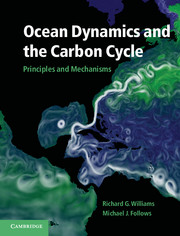Book contents
- Frontmatter
- Contents
- Preface
- Acknowledgements
- Illustration credits
- Part I Introduction
- 1 Why is the ocean important?
- 2 An introductory view of the ocean
- Part II Fundamentals
- Part III Physical Phenomena and their Biogeochemical Signals
- Part IV Synthesis
- Appendix
- Symbols and definitions
- Glossary
- Answers
- References
- Index
- Plate section
1 - Why is the ocean important?
from Part I - Introduction
Published online by Cambridge University Press: 05 June 2012
- Frontmatter
- Contents
- Preface
- Acknowledgements
- Illustration credits
- Part I Introduction
- 1 Why is the ocean important?
- 2 An introductory view of the ocean
- Part II Fundamentals
- Part III Physical Phenomena and their Biogeochemical Signals
- Part IV Synthesis
- Appendix
- Symbols and definitions
- Glossary
- Answers
- References
- Index
- Plate section
Summary
The ocean is vast, covering more than two thirds of the Earth's surface (Fig. 1.1). This reservoir of liquid water has helped determine the Earth's climate, storing and transporting heat, making the atmosphere warm and moist, and enabling life to flourish in the sea and on land. In turn, the emergence of life has altered the composition of the atmosphere, increasing the amount of oxygen and ozone, which shields harmful radiation from the Earth's surface.
The anthropogenic release of carbon dioxide is currently perturbing the climate system. The ocean is taking up typically a third of the extra carbon dioxide emitted to the atmosphere, as well as storing and redistributing much of the extra heat supplied to the climate system. To understand this ocean uptake and warming, one needs to understand how the ocean circulates, redistributing heat and carbon, how gases are transferred across the air–sea interface, how carbon dioxide reacts in seawater and the relationship between living plants and carbon.
Our aim in this book is to consider the dynamics of the ocean and effect on the carbon cycle, presenting relevant observations, and discussing the fundamental principles and mechanisms at work. In this chapter, we provide a broad context for the book, addressing how the ocean and the carbon cycle have been important in the climate system throughout Earth's history.
What is special about water?
Many important characteristics of the ocean originate from the special properties of water (Table 1.1).
- Type
- Chapter
- Information
- Ocean Dynamics and the Carbon CyclePrinciples and Mechanisms, pp. 3 - 16Publisher: Cambridge University PressPrint publication year: 2011



